
|

Up through the mid 1980s, derailer-equipped bicycles used "friction" shifting. The shifter was a simple lever held in place by friction, and the rider was expected to learn to judge how far to move it for each shift. If the lever was moved the wrong amount, the derailer might shift the chain too far, or not shift at all. It might also shift to the desired gear, but not line up quite right with the sprocket, so the chain would run rough and noisy. The rider was expected to correct this by feel and by ear. Most levers were held against cable tension by friction alone, and would eventually slip as parts wore. A small D-ring allowed adjustment of friction while riding. Simplex Retrofriction, SunTour Power Ratchet and Shimano Light Action levers were better, with a spring to resist cable tension, making frequent adjustment unnecessary.
Friction shifting required a fair amount of skill and practice even when the parts were new. Correcting shifts was difficult when urban traffic or a racing peloton masked chain noise. With older bikes, where the parts are often worn, friction shifting is often even harder to use smoothly.
After various false starts, the industry perfected "indexed" shifting in the mid 1980s. With indexed shifting, there are click stops in the shifter so that the rider has a tactile guide as to how far to move the shifter to shift from one gear to the next.
Indexed shifting is one of the most popular upgrades to older bikes, and balky friction shifting is one of the most common reasons for discarding older bikes.
Indexed rear shifting is a very worthwhile feature. Indexed front shifting, however, is of much more questionable value, especially with only two chainwheels, so the derailer's limit stops already provide indexing of a sort.
If you believe the marketing info from the parts manufacturer, you'll think that you need to replace the shifters, derailers, and everything that touches the chain. This can be prohibitively expensive on an older bike. That's part of the reason some bike shops will tell you to throw Old Faithful away and buy a new bike.
Depending on what parts your bike currently has, you may have to replace many of these parts, but often not nearly as many as you might think.
![]()
![]()
You may want to replace the rear wheel because it is worn out or damaged in one way or another, but indexing is entirely possible even with an old rear wheel that accepts a thread-on freewheel.
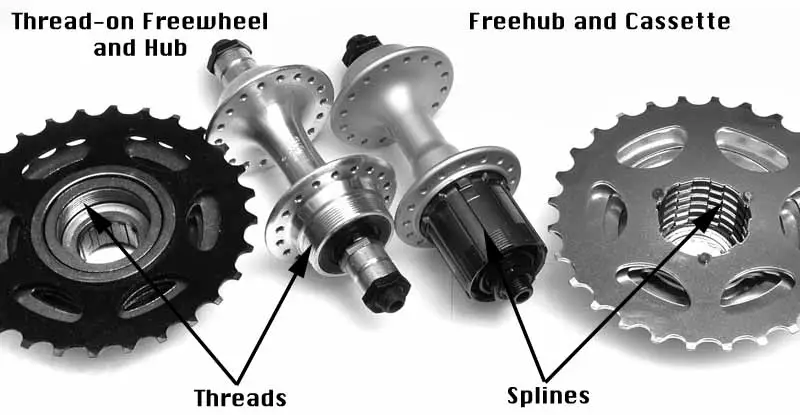
All common 7-speed freewheels, as well as Shimano 7-speed cassettes, have 5.0 mm center-to-center spacing of sprockets. Some older 6-speed freewheels (notably, SunTour Ultra-6) also have 5.0 mm spacing. New freewheels do have ramped sprockets and shaped teeth (as in Shimano Hyperglide, etc.), and will shift more smoothly, but any freewheel or cassette with 5.0 mm spacing will index with 7- and 8-speed indexed shifters, available for all kinds of handlebars. The limit stops of the rear derailer lock out excess indexing clicks. Moderate alternate cable routing may be needed for best indexing with an 8-speed shifter, because the 8-speed spacing is slightly smaller. Using an 8-speed shifter gives you the option to replace the rear wheel or cassette body later and use an 8-speed cassette. We don't recommend more than 8 speeds in any case, due to the thinner, weaker chains required to pack more sprockets into the available space. No sacrifice in gear range or step size is needed if the crankset has a small inner chainring.
If the frame was originally made for a rear wheel with fewer sprockets than you will be using, you may have to re-space for a longer rear overlocknut distance. Re-spacing is possible only with a steel frame, but on the other hand, any frame made for fewer than 7 sprockets is almost certainly steel. We have an article about frame re-spacing.
Old 5- and 6-speed freewheels and cassettes with 5.5 mm center-to-center spacing index with 5- and 6-speed Shimano Revo-Shift twist-grip shifters. These shifters fit only flat bars. You may use other shifters with alternate cable routing. You will have to replace the freewheel/cassette body to upgrade further. Only if it has French-freewheel threading will the wheel not take a modern freewheel. More information is in our articles on freewheels and cassettes.
If you change the freewheel or cassette, you can take the opportunity to make the gearing work better for you. See our article on customizing the gear range for suggestions.
To upgrade to indexed shifting, you have to replace the rear shifter, and the derailer, if it an older model not designed for indexing. This also offers an opportunity to upgrade to shifters which are more convenient, so let's look at shifter choices first.
| Old-style Shifters |
Shifters for Drop Handlebars |
Shifters for Upright Handlebars |
The Future? | ||||
|---|---|---|---|---|---|---|---|
| Downtube Shifters | Stem Shifters |
Bar-End Shifters | Combined Brake/Shifters (STI/Ergo/DoubleTap) | Thumb Shifters | Twist-Shifters | Below-Bar Shifters | Electronic Shifting |
Downtube shifters were the original type of shifter for derailer bikes, and were common through the early 1990s. It really makes a lot more sense to put all rider controls on the handlebars, but the poor performance of older derailers and the friction of older shift cables caused this frame-mounted type to be preferable in the old days. They still have their fans, who tout their light weight and simplicity, but they're pretty close to extinct. Once you get used to having the shift controls on the handlebars, you're unlikely to ever want to go back.
With downtube shifters, both levers can be shifted with one hand -- with either hand -- on bicycles with skinny frame tubes. With fat tubes, even if the frame is tall enough so the hand can reach under the top tube, the wide spacing between the levers makes shifting with one hand difficult. Downtube shifters are available with indexing, with up to 9 speeds.
The tubes of this old Cannondale are far enough apart so one hand can reach both downtube shifters, but operating both at once is difficult because of their wide spacing.
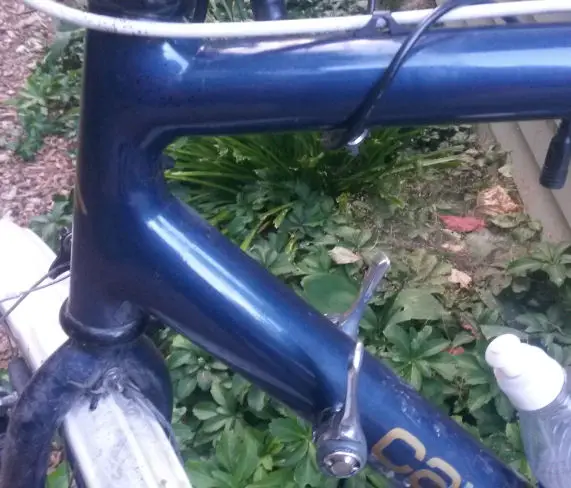
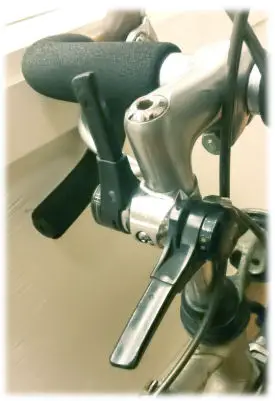 Stem Shifters
Stem Shifters Many bikes from the mid '70s through the mid '80s had shift levers mounted on the handlebar stem. Stem shifters, along with brake extension levers, encouraged riding using only the top of drop handlebars. This riding style was popular at the time, because many casual cyclists bought bicycles with drop bars for reasons of fashion and style, even though drop bars were not suited to their low-intensity riding style.
Unfortunately, this riding position gives rather poor control of the bike, mainly because the hands are too close together for good steering control. You have to remove a hand from the handlebar to shift, and shifting is awkward because there's nothing to brace the hand against while moving the lever.
Stem shifters also present a danger in a collision. Depending on what gear you have selected, stem shifters can be like having a dull knife aimed at your groin!
Shimano makes indexing ones, but really, yuck.
Up until the introduction of combined brake/shifters by Campagnolo and Shimano in the early 1990s, bar-end shifters were the only satisfactory way to mount shift controls on a drop-style handlebar. Bar-end shifters fit into the ends of the handlebars, replacing the handlebar plugs.
Bar-end shifters are the most versatile of handlebar-mounted shift options for use with drop handlebars. Modern ones are indexed for the rear derailer, but use friction shifting for the front. As a result, they are compatible with all front derailers and all chainrings.
The Shimano models even offer a selector on the rear shifter that permits it to be used either as an indexed or friction system. The D-ring shown in the photo switches between indexed and friction mode; the screwdriver slot adjusts the friction..
Bar-end shifters work particularly nicely when used with a "low-normal" derailer.
Most newer bikes that use drop handlebars have combined brake/shift levers, sometimes known as "brifters." These put all of the controls at your fingertips, allowing shifting while braking, and it has become almost impossible to sell a new bike without this style of shifters. These shifters tend to be expensive and complicated, though -- and they don't allow shifting across all the sprockets in one throw of the lever, like bar-end shifters.
Shimano STI shifter
To shift to smaller sprockets, there is button/lever on the inside of the brake hood, which is normally operated by the rider's thumb.
(An exception is the Sora model, which uses a thumb button similar to the Campagnolo Ergo system.)
![]()
![]()
Almost all upright handlebars have a diameter of 22.2 mm (7/8") and the shifters described below are designed to fit that size only.
From the earliest days of mountain bikes through the late 1980s, top-mount "thumb" shifters were the norm. These are basically similar to downtube shifters, except that they mount on the handlebars. They are still available, including indexed ones.
Twist-grip shifters have been around for many years, but the first to be really successful were the Grip Shift units from SRAM Corporation. Other manufacturers, notably Shimano, now also make them. All twist-grip shifters use indexing. This is necessary because a handlebar grip, unlike a lever, doesn't have enough range of motion to allow for accurate fine adjustment.
An early Grip Shift. Newer ones have an indicator numbering the gears.
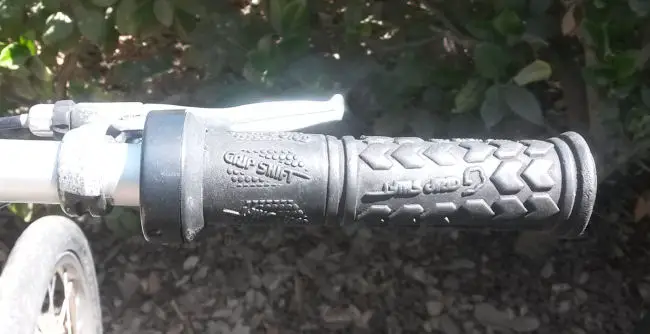
In the late 1980s, Shimano introduced "RapidFire" below the bar shifters. The first version had two buttons below the bar, intended to be operated by the rider's thumb. (This caused confusion, because the older top-mount units were known at "thumb shifters" but that name actually would have been more appropriate for the RapidFires, since the thumb was used for both upshifts and downshifts.)
The first RapidFires were not well received, in part because the upshift and downshift actions were done with the same digit, going the same direction. Riders found this confusing.
Shimano soon introduced "RapidFire Plus" shifters that used a similar thumb button to shift to larger sprockets, but a small "trigger" operated by the rider's index finger to select smaller sprockets. This version was much more successful commercially, and remains the norm for most Shimano upright-bar systems.
One issue with these shifters is that the end of the thumb button can irritate the base of the thumb when the thumb is wrapped underneath the handlebar grip.
SRAM offers DoubleTap (single-lever) versions, and there are also aftermarket brands, most of which conform to the Shimano standard for cable pull.
Like drop-bar "brifters," below-bar shifters allow braking while shifting, but require repeated presses to shift all the way across a sprocket cluster.
Shimano RapidFire Plus shifter. The thumb lever shifts to the next larger sprocket or chainwheel,
the trigger operated by the index finger, to the next smaller one.
As shown, it is possible to brake while shifting.

As of this writing in 2019, electronic shifting is available from Shimano, SRAM and Campagnolo -- but at a very high price and only with 10- or 11-speed cassettes. There are some real advantages such as automatic trimming of the front derailer and automatic double shifts, but compatibility with older frames is questionable, as is long-term reliability. Electronic shifting is not suitable for long bicycle tours in areas where replacement batteries are not available. Anyone using electronic shifting should carry a spare battery.
If a bicycle has a front derailer, with most gearing setups there will be times that you'll need to do a double shift. Usually the rear derailer handles the smaller steps and the front derailer, range changes. Both shifts are made at nearly the same time, but staggering them slightly reduces the chance of dropping the chain. It makes sense to shift whichever derailer downshifts first, so you can't get stuck in a high gear, especially when climbing.
Double shifting requires more skill than single shifts, though with indexed shifting and the controls on the handlebars, it's nowhere near as tricky as it used to be.
Older front derailer cables used a short length of housing running from a stop near the bottom of the down tube, looping down just above the left side of the bottom bracket shell, then up the back of the seat tube to the derailer. The down-tube stop was sometimes a braze-on, sometimes a clamped-on accessory.
Older front derailers incorporated a downward-facing housing stop to terminate this loop of housing.
Newer front derailers don't use housing in this area. Instead, they run bare cable under the bottom-bracket shell, then up behind the seat tube to the derailer. There's usually a plastic guide of some sort underneath the shell, which guides both the front and rear derailer cables below the bottom bracket.
Newer front derailers work a lot better than older designs, but they lack the housing stop to make them work with the old-style cable routing. This is not a difficult problem, however. All you need to do is ignore the down-tube housing stop and run the bare cable under the bottom bracket shell.
If you want to protect the paint of the bottom bracket shell, you can cut a short length, maybe 2 inches (50 mm) or so of housing to slide over the cable where it runs below the bottom bracket. This length of housing won't be working in compression as with most housing installations, since neither end will be up against a housing stop, but it will protect the paint and reduce cable friction.
You might expect the "floating" bit of housing to shift out of position over time, but this tends not to happen in practice.
Front derailers for double chainrings have a shallow cage, and for triple chainrings, a shaped inner cage plate, as shown.
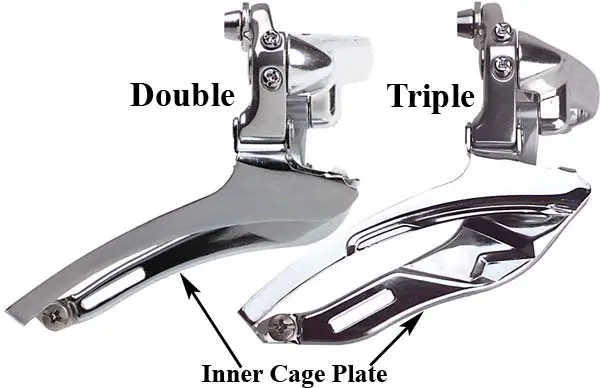
Shimano STI brifters and below-the-bar MTB shifters are indexed for the front as well as the rear. So are many of the twist grips supplied as original equipment on new bicycles.
Bar-end, down-tube and Campagnolo Ergo brifters are indexed for the rear, but use friction for the front. This is also true of most aftermarket twist-grip shifters. Older front derailers will generally be compatible with any friction shift system, but you do need to consider the chainrings to be used.
If your bike uses double chainrings, front indexing is generally not an issue, since there are only two basic positions to be used.
If your bike has triple chainrings, things get interesting! Although rear indexing is consistent for most models within a brand, Shimano's front indexing is different between the so-called "road" and "mountain" lines. Here's what that means in practice:
Shimano does make front derailers, the R440, R443 and R453 models, designed to work with upright-bar shifters and a crankset with a 52-53 tooth big ring The different models work with different-size middle rings.
Shimano no longer makes any front derailer that is compatible between drop-bar brifters and smaller chainrings.
Front derailers are designed to work with a particular-size of big ring, and the bottom edge of the outer cage plate should follow the curvature of the big chainring.
Good front shifting depends on getting the cage low and close to the chainrings, but a mismatch in curvature will make this impossible.
![]()
![]()
Older rear derailers are generally much inferior to modern ones: even quite expensive older rear derailers don't work as well as cheap newer designs.
Modern rear derailers will handle more sprockets than those originally made for, say, 5-speed freewheels. They also have the correct amount of cable pull to allow you to upgrade to indexed shifting using compatible shifters. There are workarounds to make nonstandard combinations index correctly-- see our article on drivetrain mixing.
If you are installing a freewheel or cassette with a larger inner sprocket, or a wide-range crankset, you may need to install another rear derailer. See our article on customizing the gear range for specifics.
Generally, modern derailers are completely compatible with older shift levers and freewheels, so there's no need to look for a "period" replacement even if you aren't immediately upgrading the rest of the shifting system. The one problem you might encounter is if you are using a very wide older chain with a new derailer made for a system with many more, narrowly-spaced, sprockets.
Many older frames had plain rear dropouts with no built-in provision for attaching a derailer. Most older derailers incorporated a built-in "adaptor claw" that would overlap the right dropout, providing the necessary attachment for the derailer. The adaptor claw was held in place by a small bolt through the back of the axle slot, and by the rear hub's axle nut or quick release.
The adaptor claws included with older derailers are sometimes an integral part of the derailer, other times they're detachable and interchangeable. If you want to mount a modern derailer on a frame without a built-in hanger, you can simply buy an adaptor claw...it's a standard repair part.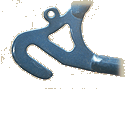 |
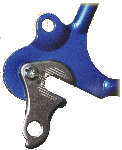 |
 |
|---|---|---|
| Plain Dropout | Adaptor Claw | Dropout with hanger |
When frames began to be built specifically for derailer use, with built-in hangers, each derailer manufacturer had its own proprietary attachment system, generally not interchangeable with other brands. Benelux, Campagnolo, Huret and Simplex, among others, had their own systems. As time went by, the Campagnolo style (shown above) became the de facto standard, and this is what all modern derailer-type frames use. It features a 10 mm thread (sometimes 26 threads per inch, sometimes 1 mm thread, which works out to 25.4 threads per inch. This pitch difference is so small as to be insignificant in this application.)
The Simplex style dropout is fairly common on older, higher-quality French bikes, including the Peugeot PX-10, Gitane Tour de France, Mercier 300, etc. Although the Simplex hanger looks similar to the Campagnolo type, it differs in two important ways: it is not threaded, and it lacks the locating notch on the bottom.
It is not difficult to convert a Simplex hanger to work with a modern derailer. All that is required is to thread it with an appropriate tap, and file a notch into the bottom of it for the "B Tension" screw to bear against.
With some derailers, the B tension screw will undershoot the notch. This can often be corrected by reversing the B tension screw, so that the screw head is bearing on the notch. That makes adjustment a bit more awkward, but this is not an adjustment that needs to be made often.
![]()
![]()
![]()
Last Updated: by John Allen